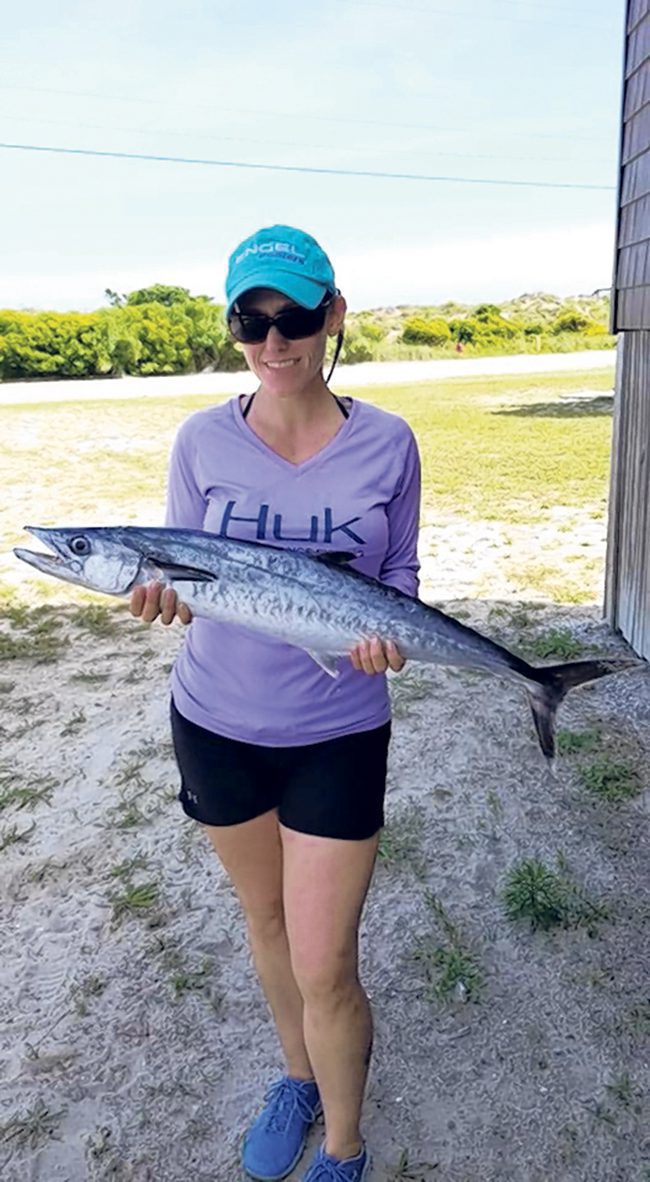Swansboro – June 21, 2018
Josh, of The Reel Outdoors, reports that surf anglers are casting for blues and spanish, and the the bottom fishermen have been bringing in some sea mullet and decent-sized pompano.
Inshore the black drum bite has been consistent, mostly on bridges and other structure. Fresh shrimp is probably the best method, but hooking a sea urchin on a Carolina rig will increase your chances of finding the bigger black drum.
There hasn’t been much action reported on flounder, but the red drum have been active. The best place to start looking for the reds are behind Bear Island and in area marshes. Live mullet on a Carolina rig is hard to beat for red drum fishing, but cut mullet has also been producing.
Off the Emerald Isle beach has seen a good mix of spanish and snake kings. Try Clarkspoons for the spanish and Big Nic Mackahoos for the kings, and start pulling baits at the closer ARs off the beach before heading out any further.

Vanessa, of Richlands, NC, with her first king mackerel. It was caught on a trolled cigar minnow in 80′ of water outside of Bogue Inlet.
Matt, of Pogie’s Fishing Center, reports that fishing has stayed consistent. The big redfish schools that were swarming the area early in the season are all broken up, and now that the days are a lot hotter, the fish are hanging out in mainland creeks and rivers. When the wind allows it, using topwater plugs in the early morning or evening should produce a fish.
Hooking up a jerk shad Gulp shrimp to a 1/8 oz. jig head will work for the reds as well. If you prefer natural baits, use cut or live mullet on a Carolina rig and fish it around oyster rocks and marsh points.
Now that summer is in full swing, flounder are becoming a lot easier to find by the day. The flatties are primarily hanging around docks, bulkheads, and bridges, and they can be caught by hooking a Gulp to a 1/4 oz. jig head or bucktail. Deeper waters and strong currents may require a little more weight to keep the bait in front of the fish.
The marshes and the White Oak River are still holding black drum. Cut shrimp on bottom rigs and small Carolina rigs are the best way to catch them.
The sheepshead bite is in full swing. Both keepers and smaller fish are being caught around area bridges by anglers using fiddler crabs on heavy Carolina or drop shot rigs. Some bigger black drum have been mixed in as well.
Rob, of Sandbar Safari Charters, reports that red drum are thick in area marshes and mudflats. They’re eating topwater baits and Gulp shrimp on the artificial side, while Carolina-rigged live or cut bait has been working as well.
Sheepshead are biting around bridge pilings and can be targeted with fiddler crabs or sea urchins. There have been a few black drum mixed in with the sheepshead, though it’s better to fish live shrimp if you’d prefer to target the black drum specifically.
The mackerel bite has been outstanding on the nearshore reefs in the 5-10 mile range. A lot of spanish and small kings have been pulled in by fishing live menhaden on the top of the water column.
If you tie on a bucktail, tip it with a scented or natural bait, and then drop it to the bottom. You can pull in a flounder or two around all the same areas where the mackerel are biting.

Paul Graham, from Newport, with a 6 lb. speckled trout caught on a Spook Jr. in the Newport River.
Johnathan, of On Point Charters, reports that red drum are still falling for Fathom Rat Tails rigged weedless, topwater baits, and both cut and live mullet. The fish have mostly been caught in the shallow bays behind the barrier islands.
Flounder are still taking the Fathom Rat Tails as well, though when targeting the flatties, hook the bait to a 1/4 oz. jig head. Mullet on a Carolina rig will work as well. On the falling tide, you can best ambush the flatties at the mouths of creeks, but fishing ICW docks will usually produce fish as well.
Docks and bridges are still holding sheepshead and black drum. Carolina-rigged fiddler crabs are still the absolute best bait for both species.
Live bait fishing for spanish and king mackerel has been incredible. The spanish have been ranging from 4-6 lbs., and the kings have been in the 5-12 lb. range. Both species of mackerel have been hanging around the nearshore ARs and have been falling for live mullet or menhaden on king mackerel rigs. Casting metal jigs works for the spanish as well.
Cobia can still be found around bait balls, and now that the water has cleared up a little more, it’s easier to sight fish with bucktails just off the beach.
Bobby, of Teezher Charters, reports that fishing the nearshore reefs has been producing a wide variety of species. Kings and big spanish mackerel, amberjack, cobia, and mahi can all be found around structure, where all the typical baits should work.
On the bottom, black sea bass and flounder are both biting.
In the Gulf Stream, trolling has been productive when targeting all the typical early summer species. Mahi, wahoo, tuna, sailfish, and marlin are all happily taking baits.
On the bottom, anglers are finding grouper, snapper, black sea bass, and triggerfish are all actively feeding.
Tammy, of Bogue Inlet Pier, reports a strong and varied catch of puppy drum, black sea bass, spots, bluefish, croaker, spanish mackerel, and sea mullet. Early mornings and afternoons have been the best times to fish, but anglers have been getting some bites all day.
